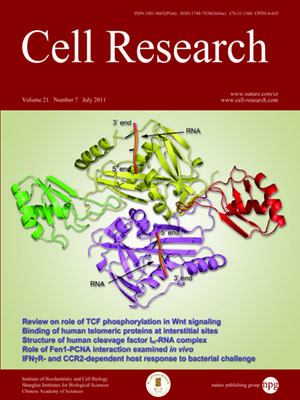
Volume 21, No 7, Jul 2011
ISSN: 1001-0602
EISSN: 1748-7838 2018
impact factor 17.848*
(Clarivate Analytics, 2019)
Volume 21 Issue 7, July 2011: 1116-1130
ORIGINAL ARTICLES
Calcium-dependent modulation and plasma membrane targeting of the AKT2 potassium channel by the CBL4/CIPK6 calcium sensor/protein kinase complex
Katrin Held1,*, François Pascaud2,*, Christian Eckert1, Pawel Gajdanowicz3, Kenji Hashimoto1, Claire Corratgé-Faillie2, Jan Niklas Offenborn1, Benoît Lac
1Institut für Biologie und Biotechnologie der Pflanzen, Universit鋞 M黱ster, 48149 M黱ster, Germany
2Biochimie et Physiologie Mol閏ulaire des Plantes (UMR 5004 CNRS-INRA-SupAgro-UM2), Campus INRA-SupAgro, Place Viala, F34060 Montpellier Cedex 1, France
3Institut für Biochemie und Biologie, Universit鋞 Potsdam, Karl-Liebkencht-Str. 24/25, 14476 Potsdam-Golm, Germany
Correspondence: Jean-Baptiste Thibaud, Jörg Kudla,(thibaud@supagro.inra.fr; jkudla@uni-muenster.de)
Potassium (K
+) channel function is fundamental to many physiological processes. However, components and mechanisms regulating the activity of plant K
+ channels remain poorly understood. Here, we show that the calcium (Ca
2+) sensor CBL4 together with the interacting protein kinase CIPK6 modulates the activity and plasma membrane (PM) targeting of the K
+ channel AKT2 from
Arabidopsis thaliana by mediating translocation of AKT2 to the PM in plant cells and enhancing AKT2 activity in oocytes. Accordingly,
akt2,
cbl4 and
cipk6 mutants share similar developmental and delayed flowering phenotypes. Moreover, the isolated regulatory C-terminal domain of CIPK6 is sufficient for mediating CBL4- and Ca
2+-dependent channel translocation from the endoplasmic reticulum membrane to the PM by a novel targeting pathway that is dependent on dual lipid modifications of CBL4 by myristoylation and palmitoylation. Thus, we describe a critical mechanism of ion-channel regulation where a Ca
2+ sensor modulates K
+ channel activity by promoting a kinase interaction-dependent but phosphorylation-independent translocation of the channel to the PM.
Cell Research (2011) 21:1116-1130. doi:10.1038/cr.2011.50; published online 29 March 2011
FULL TEXT | PDF
Browse 2214


